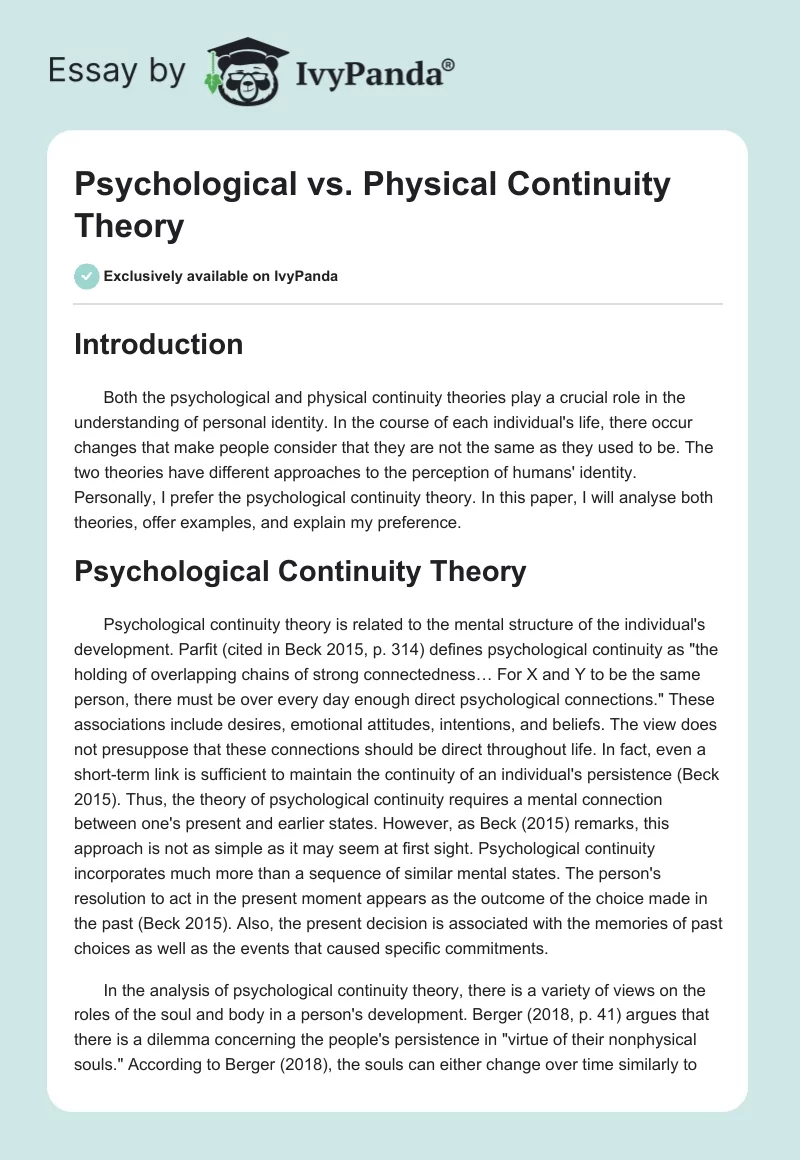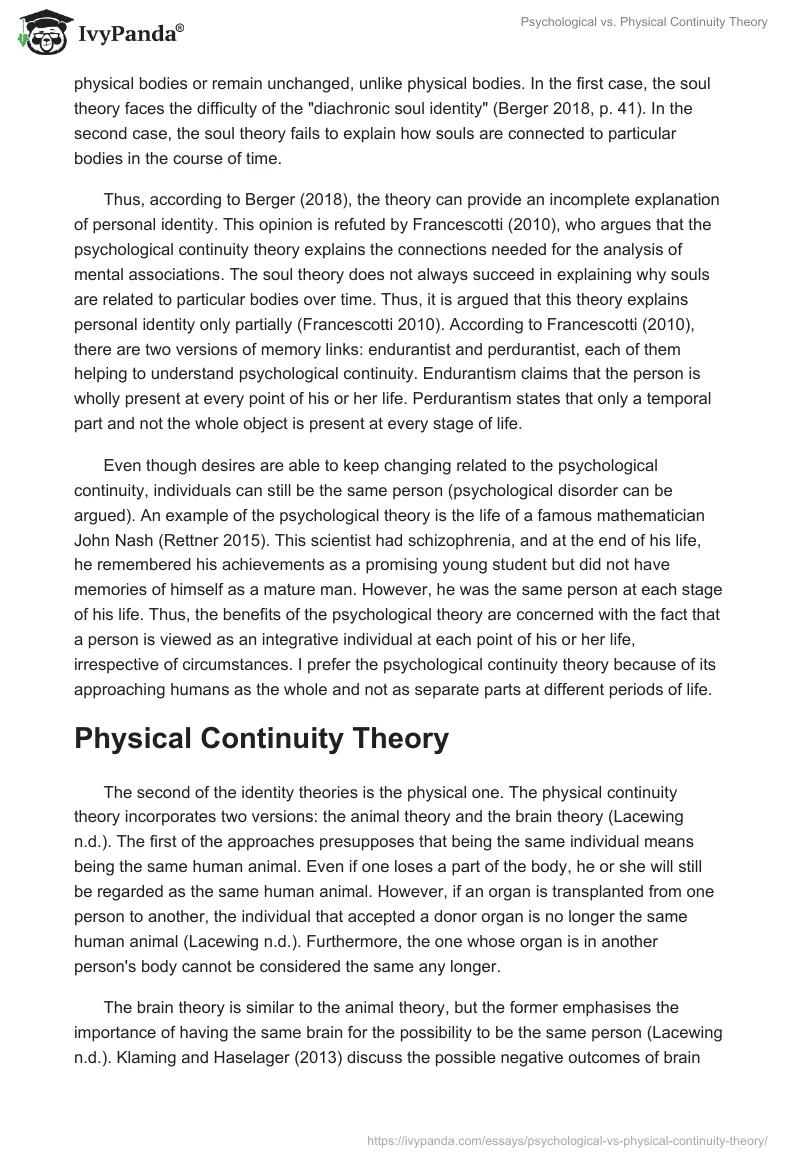Introduction
Both the psychological and physical continuity theories play a crucial role in the understanding of personal identity. In the course of each individual’s life, there occur changes that make people consider that they are not the same as they used to be. The two theories have different approaches to the perception of humans’ identity. Personally, I prefer the psychological continuity theory. In this paper, I will analyse both theories, offer examples, and explain my preference.
Psychological Continuity Theory
Psychological continuity theory is related to the mental structure of the individual’s development. Parfit (cited in Beck 2015, p. 314) defines psychological continuity as “the holding of overlapping chains of strong connectedness… For X and Y to be the same person, there must be over every day enough direct psychological connections.” These associations include desires, emotional attitudes, intentions, and beliefs. The view does not presuppose that these connections should be direct throughout life. In fact, even a short-term link is sufficient to maintain the continuity of an individual’s persistence (Beck 2015). Thus, the theory of psychological continuity requires a mental connection between one’s present and earlier states. However, as Beck (2015) remarks, this approach is not as simple as it may seem at first sight. Psychological continuity incorporates much more than a sequence of similar mental states. The person’s resolution to act in the present moment appears as the outcome of the choice made in the past (Beck 2015). Also, the present decision is associated with the memories of past choices as well as the events that caused specific commitments.
In the analysis of psychological continuity theory, there is a variety of views on the roles of the soul and body in a person’s development. Berger (2018, p. 41) argues that there is a dilemma concerning the people’s persistence in “virtue of their nonphysical souls.” According to Berger (2018), the souls can either change over time similarly to physical bodies or remain unchanged, unlike physical bodies. In the first case, the soul theory faces the difficulty of the “diachronic soul identity” (Berger 2018, p. 41). In the second case, the soul theory fails to explain how souls are connected to particular bodies in the course of time.
Thus, according to Berger (2018), the theory can provide an incomplete explanation of personal identity. This opinion is refuted by Francescotti (2010), who argues that the psychological continuity theory explains the connections needed for the analysis of mental associations. The soul theory does not always succeed in explaining why souls are related to particular bodies over time. Thus, it is argued that this theory explains personal identity only partially (Francescotti 2010). According to Francescotti (2010), there are two versions of memory links: endurantist and perdurantist, each of them helping to understand psychological continuity. Endurantism claims that the person is wholly present at every point of his or her life. Perdurantism states that only a temporal part and not the whole object is present at every stage of life.
Even though desires are able to keep changing related to the psychological continuity, individuals can still be the same person (psychological disorder can be argued). An example of the psychological theory is the life of a famous mathematician John Nash (Rettner 2015). This scientist had schizophrenia, and at the end of his life, he remembered his achievements as a promising young student but did not have memories of himself as a mature man. However, he was the same person at each stage of his life. Thus, the benefits of the psychological theory are concerned with the fact that a person is viewed as an integrative individual at each point of his or her life, irrespective of circumstances. I prefer the psychological continuity theory because of its approaching humans as the whole and not as separate parts at different periods of life.
Physical Continuity Theory
The second of the identity theories is the physical one. The physical continuity theory incorporates two versions: the animal theory and the brain theory (Lacewing n.d.). The first of the approaches presupposes that being the same individual means being the same human animal. Even if one loses a part of the body, he or she will still be regarded as the same human animal. However, if an organ is transplanted from one person to another, the individual that accepted a donor organ is no longer the same human animal (Lacewing n.d.). Furthermore, the one whose organ is in another person’s body cannot be considered the same any longer.
The brain theory is similar to the animal theory, but the former emphasises the importance of having the same brain for the possibility to be the same person (Lacewing n.d.). Klaming and Haselager (2013) discuss the possible negative outcomes of brain stimulation on psychological continuity. Thus, the authors argue that physical changes in a person’s body may cause the disruption of his or her psychological state. This is the major disadvantage of physical theory. A benefit of this approach is that it is easier to explain persistence than through the psychological theory. Also, physical theory is considered to be stronger in the identification of a person’s identity due to the appearance of oneself in a more convincing way.
The physical theory is associated with Aristotle’s conception of “Spatio-temporal continua and continuous motion” (Leggatt 1993, p. 298). According to Rowe (2013, p. 259), such continuity involves “the continuity of psychological capacities generated and sustained in a physically continuous brain.” Therefore, both theories are interconnected in what concerns the impact on humans’ body.
An example of the physical theory based on true events is the story of two neighbours donating their organs to David Conrad (Manchir 2011). The man needed a liver transplant, and two of his friendly neighbours volunteered to help. According to physical continuity theory, these people are not the same human animals. Each of the three individuals is now considered to have less physical integrity and more connection to the other two people.
Conclusion
Both psychological and physical continuity theories are sufficient and necessary for personal identity. As for me, the psychological approach makes more sense because it views the person as the same being even after some considerable changes in the organism (such as memory loss or organ transplant). Physical theory, however, refuses to accept individuals as the same after their organisms undergo some changes. The advantage of physical theory is that it allows explaining persistence easily. The benefit of the psychological theory is that it sees each person as an integrative organism. The disadvantage of both theories is that it is rather complicated to follow all of their aspects separately. However, taking into consideration all the mentioned aspects, the psychological continuity theory seems more relevant and able to explain personal identity better than the physical approach.
Reference List
Beck, S 2015, ‘The extreme claim, psychological continuity and the person life view’, South African Journal of Philosophy, vol. 34, no. 3, pp. 314-322.
Berger, J 2018, ‘A dilemma for the soul theory of personal identity’, International Journal of Philosophy and Religion, vol. 83, no. 1, pp. 41-55.
Francescotti, R 2010, ‘Psychological continuity and the necessity of identity’, American Philosophical Quarterly, vol. 47, no. 4, pp. 337-349.
Klaming, L & Haselager, P 2013, ‘Did my brain implant make me do it? Questions raised by DBS regarding psychological continuity, responsibility for action and mental competence’, Neuroethics, vol. 6, no. 3, pp. 527-539.
Lacewing, M n.d., Personal identity: physical and psychological continuity theories. Web.
Leggatt, S 1993, ‘Michael J. White: the continuous and the discrete: ancient physical theories from a contemporary perspective’, The Classical Review, vo. 43, no. 2, pp. 297-299.
Manchir, M 2011, ‘Just a liver transplant among neighbors‘, Chicago Tribune. Web.
Oyowe, OA 2013, ‘Physical continuity, self and the future’, Philosophia, vol. 41, no. 1, pp. 257-269.
Rettner, R 2015, ‘How “beautiful mind” mathematician John Nash’s schizophrenia “disappeared”‘, Live Science. Web.


